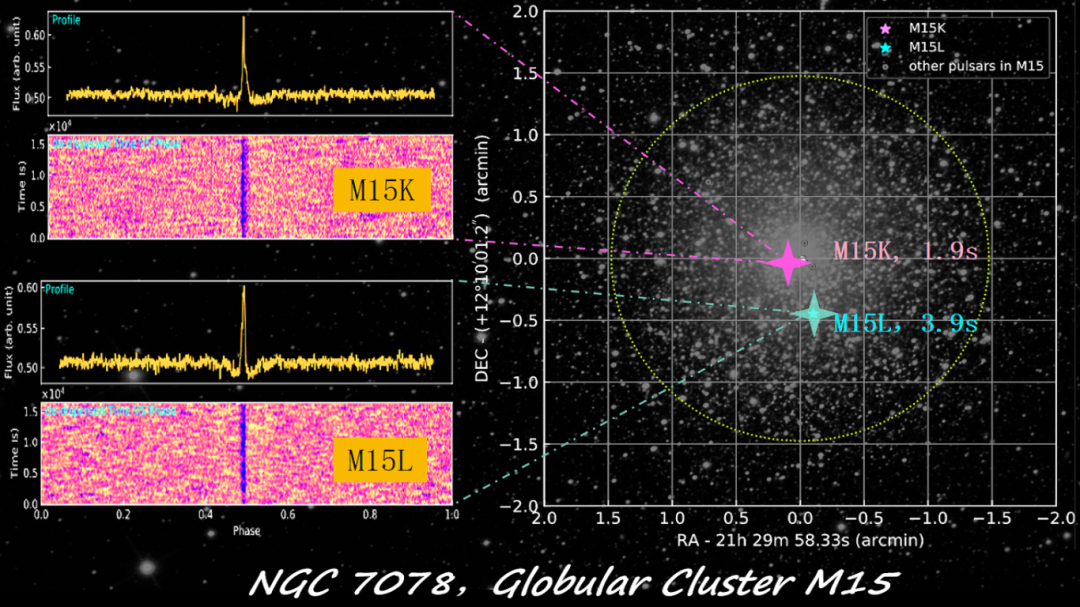

Globular clusters are gravitationally bound old clusters comprised of tens of thousands to millions of stars. While most appear spherical in shape, they can also adopt irregular shapes due to the gravitational influence of other celestial systems. The dynamic evolution of globular clusters and stellar population synthesis pathways within them have been hot topics in the field of astronomy today.
After billions of years of evolution, stars in globular clusters can collapse into dense objects, one of which is pulsars. Understanding their distribution and properties can gain deeper insights into the density and mass distribution within these clusters and their interaction with other celestial bodies, and then reveal the dynamic evolution of globular clusters and stellar population synthesis pathways.
Astronomical observations suggest that pulsars emit electromagnetic signals periodically, which is evidence of their existence in the vast universe. Currently, more than 3,000 pulsars have been discovered, and they are categorized into normal pulsars and millisecond pulsars by their rotation rate, among which about 500 millisecond pulsars have been identified, accounting for about 15% of all known pulsars. Normal pulsars rotate with a period of about 0.1 seconds to several seconds, while millisecond pulsars rotate with a period of less than 30 milliseconds.
Millisecond pulsars are distinguished from normal pulsars by their different formation histories. Normal pulsars are relatively young, typically less than a few million years old. In contrast, millisecond pulsars are relatively old, and they spin up to millisecond periods through angular momentum generated by the accretion of mass in a close binary system. The observational fact is that more than two-thirds of known millisecond pulsars are in binary systems. Globular clusters contain a high density of stars, leading to a high formation rate of binaries. Most of the 317 pulsars discovered in 41 globular clusters rotate fast in just tens of milliseconds, of which 179 are in binary systems. Astronomers are intrigued by the possibility of another class of longer-period pulsars existing within globular clusters.
Discover Long-Period Pulsars
After billions of years of evolution, pulsars should spin slower, that is, the spin period is growing longer. Why do we find so many millisecond pulsars?
"One hypothesis is that in dense globular clusters, a pulsar can easily capture a companion star and accrete material from this companion star. The material, like whipping the gyro, can speed up the rotation of the pulsar," explained Dr. ZHOU Dengke from the Research Center for Astronomical Computing of Zhejiang Lab (ZJ Lab).
However, in theory, there are many possible ways in which long-period pulsars form. One is that if two pulsars are interrupted by a third-party object during accretion and the accretion stops, then a long-period pulsar could conceivably form. The other is that white dwarfs form from collapsed old stars and merge into long-period pulsars.
So, what's keeping us from discovering more long-period pulsars? This is because most long-period pulsars have a low signal-to-noise ratio (SNR), and they are considerably subjected to red noise that arises during long-term telescope observations, making it extremely challenging to detect long-period pulsars.
To address difficulties in long-period pulsar detection, ZHOU Dengke, together with WANG Pei, an Associate Research Fellow from the National Astronomical Observatories of the Chinese Academy of Sciences (NAOC), and LI Di, a Research Fellow from NAOC, used a new search scheme and successfully discovered long-period pulsars in globular clusters in the past year or so.
"First of all, through simulation and quantitative analysis, we systematically evaluated the influence of red noise on the sensitivity of searches for long-period pulsars. On this basis, appropriate parameters were carefully selected by using the simulation results in order to effectively remove red noise from data. Furthermore, we utilized FFA (fast-folding algorithm) to search in detail and in depth for long-period pulsars in publicly available observational data of several globular clusters from FAST," said ZHOU Dengke.
Finally, the research team discovered two long-period pulsars in the globular cluster M15, called M15K with a spin period of 1.9 seconds and M15L with a spin period of 3.9 seconds. M15L is also the current longest-known pulsar in globular clusters. "This discovery reveals a new evolutionary pathway for pulsars in globular clusters. FAST is systematically changing our understanding of pulsars in globular clusters," said LI Di, the corresponding author of the paper and Chief Scientist of FAST.
The groundbreaking discovery was published as a cover article of the well-known academic journal SCIENCE CHINA Physics, Mechanics & Astronomy on April 18, 2024.

Fig. 1 Two long-period pulsars recently discovered in M15. Left panel: M15K & M15L pulse profile and phase-time waterfall plot. Right panel: M15K & M15L position in M15. Source: Zhou et al., 2024, Sci. China-Phys. Mech. Astron., 67, 269512.
The research team further analyzed the physical properties of these two pulsars and found that they possess relatively strong magnetic fields compared to other pulsars in globular clusters. "Pulsars may weaken their magnetic fields during accretion, so their strong magnetic fields further indicate that they underwent brief binary accretion processes," said ZHOU Dengke, the first author of the paper.
Find Rules from Data
In this study, the team processed about 90 hours of data, totaling about 50TB, from FAST observations in 2019-2022. From these original observations to the final identification of pulsars, several steps must be performed, including de-dispersion, parameter setting, interference elimination, red noise removal, periodic search, candidate selection, cross validation, and timing analysis, which involve extensive data processing and consume significant computing resources.
The first thing is de-dispersion. Pulsar signals are dispersed during their propagation through the interstellar medium, causing high-frequency signals to reach the Earth earlier than low-frequency signals. In order to obtain high-SNR pulse signals from the superposition of signals with different frequencies, data processing must start with de-dispersion.
"The astronomical computing team of ZJ Lab has optimized de-dispersion software, multiplying data processing efficiency," said ZHOU Dengke.
De-dispersion is just the first step, and the subsequent candidate selection step is more time-consuming and labor-intensive. Since massive candidate graphs are generated from searches by parameter estimation and FFA, researchers have to visually determine if the graphs conform to pulsar signal characteristics.
"Given that tens of thousands of candidate images are probably generated in just one hour of observation, it is very difficult to distinguish very weak signals from so many images," said ZHOU Dengke. However, by leveraging the AI vision model developed by the Research Center for Astronomical Computing, the candidate information can be filtered efficiently, and the number of candidates to be filtered with manual intervention can also be reduced by three orders of magnitude.
"Nowadays, it is very time-consuming to process astronomical data due to their huge volume. Utilizing intelligent computing technologies such as AI algorithms, to assist in processing these data can alleviate the burden of heavy data analytics workload, enabling us to dedicate more energy to understanding the physical images behind the data. This greatly enhances the efficiency of scientific research," said ZHOU Dengke.

ZHOU Dengke
Intelligent computing has become essential in ZHOU Dengke's research. Next, he plans to correct the Doppler effect in binary systems before searching for long-period pulsars in globular clusters, so as to make searches more complete. Additionally, he will train the AI model capable of identifying Doppler phase shift images to increase computing speed and expedite the entire search process.
"The job of astronomers is to try to find or verify the fundamental laws of nature from the analysis of astronomical observations. In the days without modern computational tools, astronomers represented by Johannes Kepler derived the laws of planetary motion from massive astronomical observations. Now we can take advantage of large-scale computing clusters and intelligent computing techniques. In this way, research efficiency is significantly improved. For example, this new discovery offers unique samples, shedding light on the evolutionary pathways of stellar populations. The parameters of multiple pulsars can also be used to constrain the gravitational potential and mass of central objects associated with globular clusters. We want to leverage large-scale computing clusters and intelligent computing technologies to distill more fundamental laws of nature from data, just like Johannes Kepler," said ZHOU Dengke.











